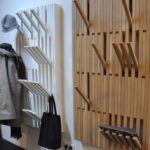Introduction
A woodworking chamfer is a type of beveled edge on a piece of wood. It is usually a 45 degree angle that miters into two pieces and creates a smooth, polished edge. Woodworkers will often use chamfering to add style and flair to the edges of projects or to cover up any imperfections.
Measuring a woodworking chamfer accurately can be important for several reasons. First, it helps ensure the success of the project, as the angles must all match perfectly in order for the finished product to look its best. Second, depending on your designs and plans, precise measurements may determine if certain components fit properly together within your design. Third, accurately measuring the chamfers lets you adjust each one if needed until they are all equal in size and shape. Finally, measurements help provide direction on how to complete different parts of a project or modify existing work with precision.
The best way to measure a woodworking chamfer is with a protractor tool along with an adjustable ruler or square tool. To measure with this technique place your protractor directly against the cut edge at 90 degrees making sure that it is level across both edges before tracing around it with either pencil or marker; this will create an accurate outline along both edges. Then adjust your ruler or square so that its length matches each side of the outlined area and record the measurement at each point; this will give you an exact measurement for the length and width of each angled section of your chamfer allowing you to make any needed adjustments before continuing to shape and finish your project’s edges.
Definition and Terminology
A chamfer is an angled cut across the end or edge of a material, generally with the purpose of providing a smooth transition between two pieces of material. In woodworking, a chamfer may be created by planing a surface at an angle, or by routing it to make the corner rounded. A woodworking chamfer can also be made with either a skew chisel or a router bit.
To measure your woodworking chamfer accurately and get desired results, there are several different types of measurement tools you’ll need depending on how you want to measure the angles and corners. For example, if you’re planning on making angled cuts in two pieces of wood, such as for creating a miter joint, then you’d need to use something like a protractor or angle finder to determine the exact angle between them. You could also use specialized tools like a 45-degree table saw blade for easier measuring and cutting of shallow angles like those found in crown moulding and trim applications. Or if you have deep angled cuts where precision is essential then you might prefer to use tools like calipers or micrometers that allow more accuracy when measuring exact dimensions in woodworking projects. Finally, if yourWoodworking project requires making large chamfers then you’ll likely want to use something like either a spiral-cutting jig or router sled which can help increase consistency while ensuring accurate measurements everytime.
Tools and Materials Needed to Measure a Woodworking Chamfer
Measuring a Woodworking Chamfer is an important part of any woodworking project. To ensure your finished project looks professional, accurate measurements must be taken. Here are the tools and materials you need to accurately measure a woodworking chamfer:
1. Calipers: The most important tool for measuring a woodworking chamfer. Calipers feature two levers with depth gauges and are used to accurately measure the depths of various cuts in wood or other material.
2. Pencils and Markers: A simple pencil or marker can be used for marking the angle where the chamfer meets the workpiece surface. This will help make sure that both sides of your chamfer match when complete.
3. Tape Measure: Used to precisely measure distances between each side of your chamfer cuts such as if using dovetail joint techniques or measuring individual segments in case multiple sections make up wider boards such as on vintage furniture components, etc…
4. Compass: When setting up the compass use it to trace out circles that represent each side of the desired chamfers cutout shape helping you refine and specify the exact lines before cutting any material away.
Step-by-Step Instructions on How to Measure a Woodworking Chamfer
1. Begin by selecting a straight ruler or measuring tape that is long enough to measure the entire chamfer.
2. Place the ruler along the edge of the wood where you will be measuring the chamfer. Make sure that it aligns with both edges of the corner you will be measuring, and use a pen or marker to mark them on the ruler.
3. Now take a protractor or an angled drafting triangle and place it perpendicular to your ruler so that one of its arms is aligned with the edge at which you will start your measurements. You may want to use a paperclip or something similar as a weighting device, because based on how long your measurements are going to be, even light pressure on one part can throw off accuracy in your readings.
4. Position your protractor’s arm steeply against the edge at which you have started measuring the chamfer so that you have room to read accurately along its length and into the corner angle between both edges of the wood. Keep in mind that it’s best when all angles are measured perpendicular to each edge in order for accurate readings to be taken throughout as opposed to dealing with discrepancies caused by too many levels being triangulated from different planes and directions if done incorrectly.
5. After setting up your protractor arm against one side of your corner, proceed with calculating out lengths along both sides using simple mathematics, using successive subtraction from what each tip axis measurement was at before (e.g from 10 degrees down south-east toward 8degrees north-west). This way it gets easier for you than having wildly changing measurements across all four sides just trying to gauge each chamfer angle without taking reference points into consideration before starting out calculations and recording individual parts of it down on paper for accurate references later during final assembly prep stage(s).
6. To ensure accurate measures as each side is calculated out, double check them by connecting two opposing edges together either by running physical lines around them and through their endpoints (if they are not separate individual parts but connected) or writing respective distances off into separate square outlines able to narrate detailed steps outward towards reaching any total measurement you recorded previously after setting up basic reference points correctly lengthwise along each border line in question – this allows manual examination confirmation more so than relying blindly solely upon digital calculators when dealing with stiffer material wherein solid sheer strength variations might occur over thinned bordering joins due stress being maximally forced between them during stages prior workmanship build up activities…. Or depending if generating finished trimmings needs guaranteeing overall tightness/smooth action without friction wear coming afterwards inevitably as per usual operations routine flow – then extra caution must be put onto meeting alignment specs within understandable tolerances across any specific geometrical form projection involved within general construction schematic!
Understanding Chamfer Shapes and Calculations
A chamfer is a type of bevel that is used in woodworking to create an angled edge. The chamfer can come in many shapes, ranging from a 45 degree angle up to 90 degrees and beyond. To measure a woodworking chamfer, the easiest way to do so is by measuring the angle of the bevel that appears at each corner. This can be done with either an analog or digital protractor or an appropriate ruler or gauge.
When measuring the angle of a chamfer, it is important to note that what may seem like a perfect 45-degree corner when looking at it straight on might not actually be so; there is usually some variance due to irregularity between pieces being joined together. Therefore, it is important to use accurate tools such as those mentioned above when making precise measurements. Additionally, it may also require measuring multiple points around the perimeter and averaging out those values in order to get an accurate measurement of the average angle formed by the chamfer.
Once one gets used to calculating angles needed for making particular projects with their chosen tools, they can begin customizing chamfers further and creating unique designs according to individual preference and application requirements. For example, cutting rail ends on furniture often requires creating very shallow corners which are accomplished by running two separate cuts of different angles; these would need to be carefully measured in order for them to fit together perfectly for creating an aesthetically pleasing finish product. Understanding basic formulas and calculations also helps in accurately figuring out what dimensions need to be cut in order for each piece of work join seamlessly together over time.
Common Mistakes to Avoid When Measure a Woodworking Chamfer
Measuring a woodworking chamfer is a critical skill to have when constructing furniture or other wooden items, and it’s important to get it right. Any mistakes made while measuring can have disastrous consequences on the overall piece, so it’s important to avoid any common mistakes while tackling this job. Below are some warning signs and tips for success to help ensure you get a precise measurement when measuring a woodworking chamfer.
Warning Signs: If your measurements come out wrong, or if they are inconsistent across the board – these could be signs that you have not correctly measured your woodworking chamfer. This could lead to gaps in the finished product, or pieces fitting together too closely.
Tips for Success: The best way to measure a woodworking chamfer is with a protractor specifically designed for the task. Alternatively, you can use measurements like “11/16 of an inch” for reference points along the chamfer edge – then make sure those points correspond with each other before continuing with construction. Also make sure that you take enough time to accurately measure all sides of the chamfer and double-check your work before starting construction in earnest – this will save you from any costly mistakes down the line. Finally, making multiple marks on an angle is also recommended in order to guarantee accuracy in your subsequent cuts or finishes.
Wrapping Up
Measuring woodworking chamfers can be a tricky process. It often requires precision, planning and patience to get the job done safely and accurately. The pros of doing it yourself include that you get the exact measurements that you want, and if done right, it will add functionality to your workpiece. However, one potential downside is that it can be time consuming and difficult to achieve the desired result if not done properly. Additionally, if you don’t have tools that are capable of producing precise cuts and angles, then getting accurate results can prove difficult.
When measuring a chamfer, it’s important to pay attention to the angle referenced in your design plans so you know exactly how much material to remove. Always remember safety tips such as wearing protective eyewear when working with any cutting or grinding tool; this will help ensure accuracy and protection from any stray particles or flying debris that could potentially cause injury.
Overall, woodworking chamfers can add a nice touch to your projects but take extra precision and care when measuring them ” plan ahead as much as possible with your angles, use proper safety measures when using cutting tools, and patient patience for best results! And remember”measuring woodworking chamfers doesn’t have to be daunting ” with these tips in mind, you’ll make sure you get the perfect chamfer each time with ease. Ultimately, measuring woodworking chamfers is a great way to bring added dimensionality to your project while saving yourself time in the long run!

Hi everyone! I’m a woodworker and blogger, and this is my woodworking blog. In my blog, I share tips and tricks for woodworkers of all skill levels, as well as project ideas that you can try yourself.





